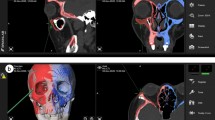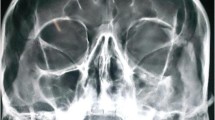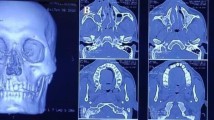Abstract
Purpose
Zygomatico-orbital (ZMO) fractures pose considerable difficulty in intraoperative assessment during open reduction and internal fixation (ORIF), and this can be attributed to its three-dimensional complex anatomy and articulations. Recent advancements in the form of intraoperative imaging and navigation have led to an adequate assessment and correct reduction of these fractures minimizing chances of any revision surgery. The purpose of this study was to evaluate the advantage of intraoperative computerized tomography (CT) scan in the management of ZMO/isolated orbital complex fracture and further to develop a protocol for managing such fractures.
Methods
Twenty-three cases of ZMO/isolated orbital fractures were managed with ORIF, followed by an intraoperative CT scan. The evaluation was focused on the articulations of the zygoma and orbital wall reconstruction. The score of 0 and 1 was given for inadequate and adequate reduction, respectively. Necessary corrections were performed in case of improper reduction followed by a repeat CT scan if required. The reduction score was statistically correlated with number of incisions.
Results
In 8 (35%) out of 23 patients, clinical judgment was inaccurate when radiologically assessed with an intraoperative CT scan. In 6 out of 8 cases, a repeat CT scan was done after revision of reduction. The reduction score improved with additional incision and revision in the second CT scan.
Conclusion
Intraoperative CT has an important role in assessing the accuracy of reduction and confirming implant position in ZMO/isolated orbital fractures. This can avoid the need for secondary corrective surgery and postoperative imaging. Intraoperative CT is an important tool to improve surgical outcomes in the management of ZMO orbital fractures.














Similar content being viewed by others
References
Ellis E, El-Attar A, Moos KF (1985) An analysis of 2,067 cases of zygomatico-orbital fracture. J Oral Maxillofac Surg. 43(6):417–428
Ellis E, Kittidumkerng W (1996) Analysis of treatment for isolated zygomaticomaxillary complex fractures. J Oral Maxillofac Surg 54(4):386–400
Ridgway EB, Chen C, Colakoglu S, Gautam S, Lee BT (2009) The incidence of lower eyelid malposition after facial fracture repair: a retrospective study and meta-analysis comparing subtarsal, subciliary, and transconjunctival incisions. Plast Reconstr Surg 124(5):1578–1586
Antonyshyn OM (1999) Soft tissue deformity after craniofacial fracture repair: analysis and treatment. J Craniomaxillofac Trauma 5(3):19–29
Matic DB, Kim S (2008) Temporal hollowing following coronal incision: a prospective, randomized, controlled trial. Plast Reconstr Surg 121(6):379–385
Wilde F, Lorenz K, Ebner AK, Krauss O, Mascha F, Schramm A (2013) Intraoperative imaging with a 3D C-arm system after zygomatico-orbital complex fracture reduction. J Oral Maxillofac Surg 71(5):894–910
Hoelzle F, Klein M, Schwerdtner O et al (2001) Intraoperative computed tomography with the mobile CT Tomoscan M during surgical treatment of orbital fractures. Int J Oral Maxillofac Surg 30(1):26–31
Westendorff C, Gülicher D, Dammann F, Reinert S, Hoffmann J (2006) Computer-assisted surgical treatment of orbitozygomatic fractures. J Craniofac Surg 17(5):837–842
Stuck BA, Hulse R, Barth TJ (2012) Intraoperative cone beam computed tomography in the management of facial fractures. Int J Oral Maxillofac Surg 41(10):1171–1175
Czerwisnki M (2015) C-arm assisted zygoma fracture repair. A critical analysis of the first 20 cases. J Oral Maxillofac Surg 73(4):692–698
Heiland M, Schulze D, Blake F, Schmelzle R (2005) Intraoperative imaging of zygomaticomaxillary complex fractures using a 3D C-arm system. Int J Oral Maxillofac Surg 34(4):369–375
Gruss JS, Van Wyck L, Phillips JH, Antonyshyn O (1990) The importance of the zygomatic arch in complex midfacial fracture repair and correction of posttraumatic orbitozygomatic deformities. Plast Reconstr Surg 85(6):878–890
Pedemonte C et al (2016) C-arm as intraoperative control in reduction of isolated zygomatic arch fractures: a randomized clinical trial. Oral Maxillofac Surg 20(1):79–83
Abubaker AO, Sotereanos G, Patterson GT (1990) Use of the coronal surgical incision for reconstruction of severe craniomaxillofacial injuries. J Oral Maxillofac Surg 48(6):579–586
Ellis E, Perez D (2014) An algorithm for the treatment of isolated zygomatico-orbital fractures. J Oral Maxillofac Surg 72:1975–1983
Shumrick KA, Kersten RC, Kulwin DR, Smith CP (1997) Criteria for selective management of the orbital rim and floor in zygomatic complex and midface fractures. Arch Otolaryngol Head Neck Surg 123(4):378–384
Yu H, Shen G, Wang X, Zhang S (2010) Navigation-guided reduction and orbital floor reconstruction in the treatment of zygomatic-orbital-maxillary complex fractures. J Oral Maxillofac Surg 68(1):28–34
Rabie A, Ibrahim AM, Lee BT, Lin SJ (2011) Use of intraoperative computed tomography in complex facial fracture reduction and fixation. J Craniofac Surg 22(4):1466–1467
van Hout WM, van Cann EM, Muradin MS, Frank MH, Koole R (2014) Intraoperative imaging for the repair of zygomaticomaxillary complex fractures: a comprehensive review of the literature. J Craniomaxillofac Surg 42(8):1918–1923
Masaryk T, Kolonick R, Painter T, Weinreb DB (2008) The economic and clinical benefits of portable head/neck CT imaging in the intensive care unit. Radiol Manag 30(2):50–54
Funding
None.
Author information
Authors and Affiliations
Corresponding author
Ethics declarations
Conflict of interest
The authors declared that they have no conflict of interest.
Ethical approval
Yes.
Informed consent
Yes.
Additional information
Publisher's Note
Springer Nature remains neutral with regard to jurisdictional claims in published maps and institutional affiliations.
Rights and permissions
About this article
Cite this article
Sharma, P., Rattan, V., Rai, S. et al. Does Intraoperative Computed Tomography Improve the Outcome in Zygomatico-Orbital Complex Fracture Reduction?. J. Maxillofac. Oral Surg. 20, 189–200 (2021). https://doi.org/10.1007/s12663-020-01420-0
Received:
Accepted:
Published:
Issue Date:
DOI: https://doi.org/10.1007/s12663-020-01420-0




